by Helen Bradshaw | June 9, 2025
Florida’s Feral Flocks: The Chickens of Ybor City and Key West
Why Florida's iconic feral flocks in Key West and Ybor City just might hold the key to saving chickens everywhere.
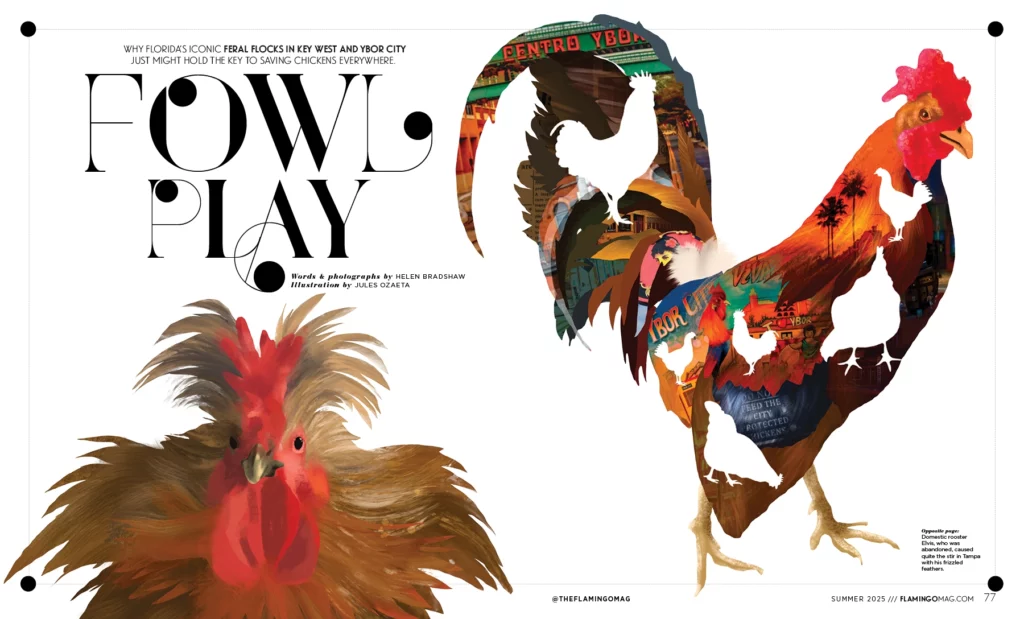
Every night in Ybor City, as booming music began to resonate from cigar factories-turned-nightclubs, Elvis hid in the shadows. For the streets full of young Floridians ready for a night they can’t remember, it was fun. For him, it was a threat.
This Elvis didn’t have blue suede shoes or a hip swivel that could make anyone swoon like his namesake. But he did have similarly iconic dark coiffed locks, an aesthetic that earned him more trouble than acclaim in the street chicken world. That’s why each evening as the sun bid adieu to Ybor, chicken rescuer Dylan Breese tuned out the music and tuned in to the tiny taps of talons on pavement and the little flutter of unsuccessful wings.
By day, Elvis had all the suave appeal of The King, with his curled, frizzled feathers rocking the streets of the Northeast Tampa enclave known as Cigar City. But at night, Elvis’s unique plumage was trouble. Abandoned in the streets of Ybor, Elvis lacked the feral genetics to survive. He quite literally wasn’t born for this: his unruly feathers couldn’t catch enough wind to roost as high as other birds, leaving him to hide in bushes, unable to fully escape the crowds and chaos of nightlife.
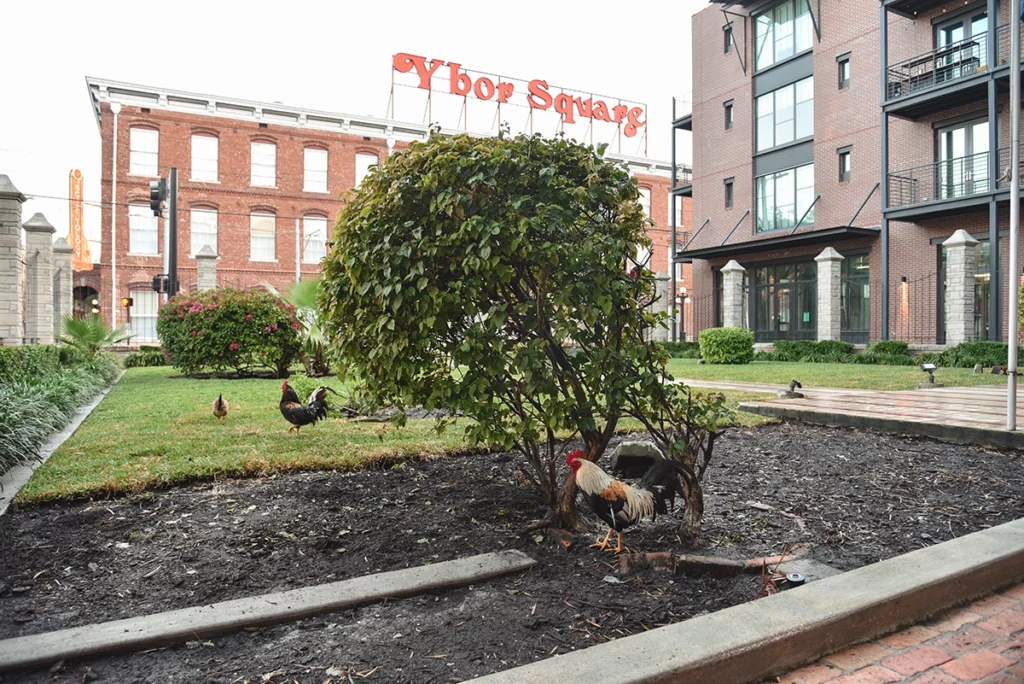
“He would come up to me and wait for me to pick him up,” Breese says. “I put him on the lowest branch of his favorite tree, and he would climb up the rest of the way. And if I happened to see him the next morning, we would admire each other from a distance, not get too close. He was either
embarrassed or he wanted to party later than the rest.”
Ybor’s feral chickens are the Tampa chapter of a storied lineage—birds that have crossed turbid oceans, outlived cockfighting rings and carved out an existence in Florida’s streets. Their most famous cousin flock roams Key West, dodging mopeds instead of Gasparilla-goers. These birds are scrappy, charismatic and woven into the cultural fabric of their cities—just check any Key West gift shop. But beyond their streetwise charm, they may hold something far more valuable: genetic resilience. As avian diseases like bird flu threaten global poultry stocks, Florida’s wild flocks could be an unexpected lifeline for the future of farming.

The Chicken Guardian of Tampa
Elvis is a favorite, but really, most of Tampa’s chickens view Breese with the same admiration. He’s rescued upward of a thousand birds in the city: some abandoned like Elvis, but
others born-and-raised Ybor chickens that ended up in a rough spot. He’s treated wounds, raised orphaned babies and even retrofitted a shop vacuum to suck chicks out of drains. And every bird gets just as much dedicated attention as Elvis, and their own name to show it—just ask Ruane, Dottie or Buckeye.
Breese started rescuing chickens in Ybor when he still lived in a condo, before he even had an outdoor space of his own. “What I’d have to do, if I had a bird that I was trying to take care of, was find a place to hide it in the neighborhood—behind an abandoned building, or I would build little houses out of palm fronds and pieces of wood where I would keep the birds I was taking care of. I really didn’t know of any other resources at the time,” he says.
In 2020, Breese launched the Ybor Misfits Microsanctuary, the city’s first nonprofit dedicated to protecting and rehabilitating the city’s iconic chickens. Gone are the days of makeshift chicken shelters behind abandoned cigar factories. Now, he’s got it down to a science. As soon as Breese gets a text that a bird might be in danger, he starts coordinating a response. “I have hooks for storm drains to get babies out,” Breese says. “I have a bag with antimicrobial sprays, Terramycin, gauze, powder that stops the bleeding. I have a snake camera if I need to find a baby that’s in a tunnel. I have my nets.”
Everywhere the migrant tobacco workers settled and moved on from, they’ve left these types of birds in the streets.
—Dylan Breese
After nine years of rescuing the neighborhood’s chickens, he’s become fluent in their language—30 distinct vocalizations, from the soft purr of contentment to the sharp, urgent call of a predator sighting. And when that stress call rings out, Breese reacts instinctively.
“I’ve almost become one of them,” says Breese, who works as an engagement services manager in higher education and is the executive director for a nonprofit maker’s market when he’s not saving the flock. In Ybor City, if you’re willing to listen, most moments aren’t just punctuated by music or traffic—there are also the clucks of over a hundred nearby chickens. This is the sound of Breese’s Ybor City, a cacophony of chicken calls thanking him for his help, letting him know they need him or warning sloppy spring breakers to back off.
Find out where you can take a yoga class with the chickens of Ybor City

From India to Ybor
Every chicken in Ybor and Key West, and every domesticated chicken worldwide, traces its lineage to the dense forests of Southeast Asia. To the untrained eye, India’s red jungle fowl, a species of wild birds with a shriek of a call, might just seem like a skinnier, scrappier version of today’s chicken. Their domestication began 3,500 years ago in the region’s rice fields, where the feathered forefathers were first attracted to humans—a connection that eventually led to a new subspecies: Gallus gallus domesticus, also known as the modern chicken.
From there, the birds gradually dispersed around the world, where they were often prized for their value as a food source. But by around 400 B.C.E., the birds entered a different kind of slaughterhouse: the cockfighting ring.
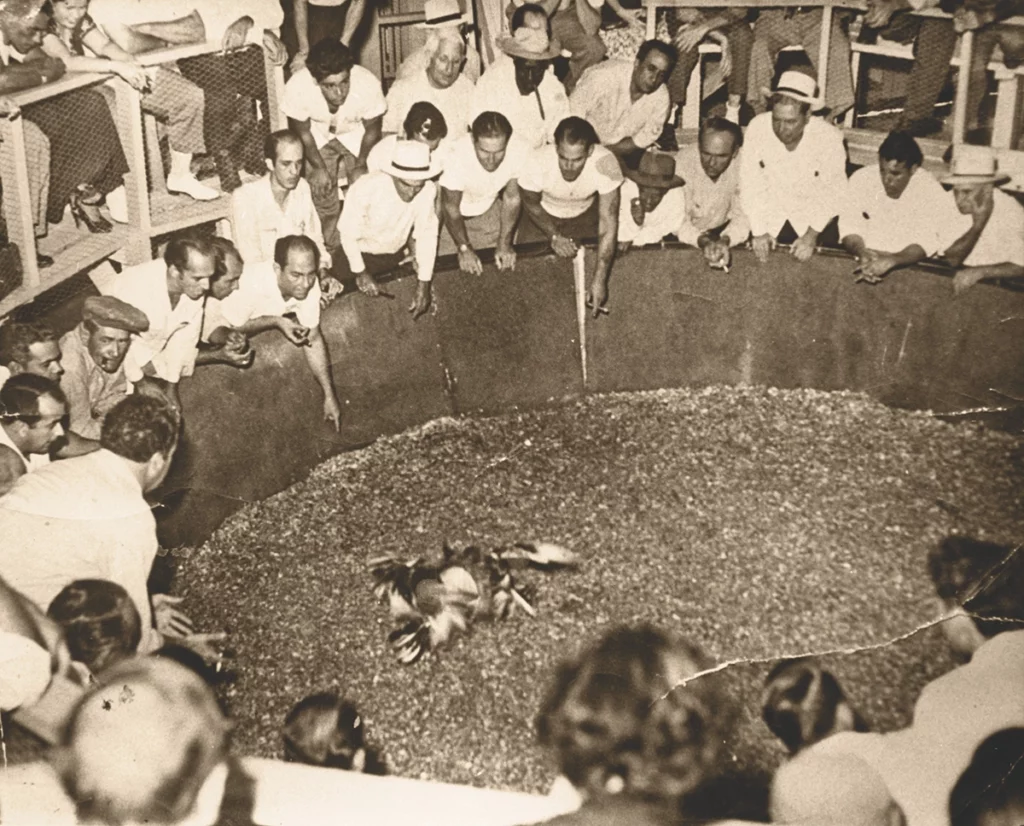
Cockfighting birds are jungle fowl on overdrive. Think Brad Pitt in “Fight Club”—lean and agile, but still built for battle. These birds are quick enough to dodge a poultry punch and tough enough to throw one right back. They’re tall and wiry, and many have spurs that would make any cowboy pause. They’ve left their mark on the cultures of the Conch Republic, becoming a symbol of resilience and toughness in the process.
“People just brought them in. (Chickens) were easily transportable. They were easy to raise,” says Corey Malcom, the lead historian at the Florida Keys History Center. “There are other accounts of people coming from Cuba and … having chickens on board the boat … So that was really the beginning.”
As the cigar industries in Key West and Ybor City began to boom in the late 1800s, people flocked from the Caribbean to these areas, bringing their cockfighting and backyard laying birds with them. Wherever the smoke blew, the birds followed. In the early 20th century, more than 100,000 Cubans moved between Tampa, Key West and Cuba annually. These migrants carried cultural and iconic items to remind them of these places—clothing, food, cigars, music and, evidently, their beloved chickens.
“Everywhere the migrant tobacco workers settled and moved on from, they’ve left these types of birds in the streets,” Breese explains. “So you see pictures of Cuba, and it’s the same bird on the streets. And in Key West, the same types of birds are existing in the streets when Vicente Martinez Ybor moved his entire operation (from there) to the town of Tampa.”

But the cigar industry in both towns eventually waned. Today, there’s only one remaining large-scale operating cigar factory left in Ybor City. Then the two towns began to change in other ways, too.
Down in Key West, the area’s first grocery, Fausto’s Food Palace, opened in 1926. A string of other grocery stores followed. Suddenly, eggs came refrigerated by the dozen and chicken breasts came perfectly packaged. Backyard birds grew obsolete as the introduction of the modern supermarket led to the gradual dissolution of home coops. “You see (feral) chickens really starting to take off here because nobody is watching them anymore,” Malcom says.
These free birds cautiously expanded their reign from neighborhood backyards to bushes on Duval Street and bricks in Mallory Square. As they migrated, Malcom says the chickens became a symbol of the city: “I’d say that around 2000, we started seeing them become the Mickey Mouse of Key West.”
And now, on any given morning in Key West, well before tourists are even awake enough to question if they really saw the green flash or they just stared at a Key-lime-rita a little too long the night before, the chickens are out. They search for bugs and seeds in multimillion-dollar yards, dodge cats that are almost definitely related to Hemingway’s six-toed squadron and roost in banyan trees that have watched the cityscape change for centuries. Florida’s chickens know their way around their cities better than any human local.
Ybor City’s chickens are not just a quirky charm—they embody the neighborhood’s grit.
—Dylan Breese
There’s no genetic study of Florida’s feral birds to confirm what combination of fighters, backyard birds and jungle fowl comprise the modern chicken. However, Eben Gering, an evolutionary biologist at Nova Southeastern University who studies feral birds, is confident about a few things. For one, the genes that made their ancestors so great at cockfighting are probably still present in the feral chickens found around Key West today. “One thing that is definitely the case—the (Key West) males are very aggressive with each other, much more so than Bermuda and Hawaii,” he says.
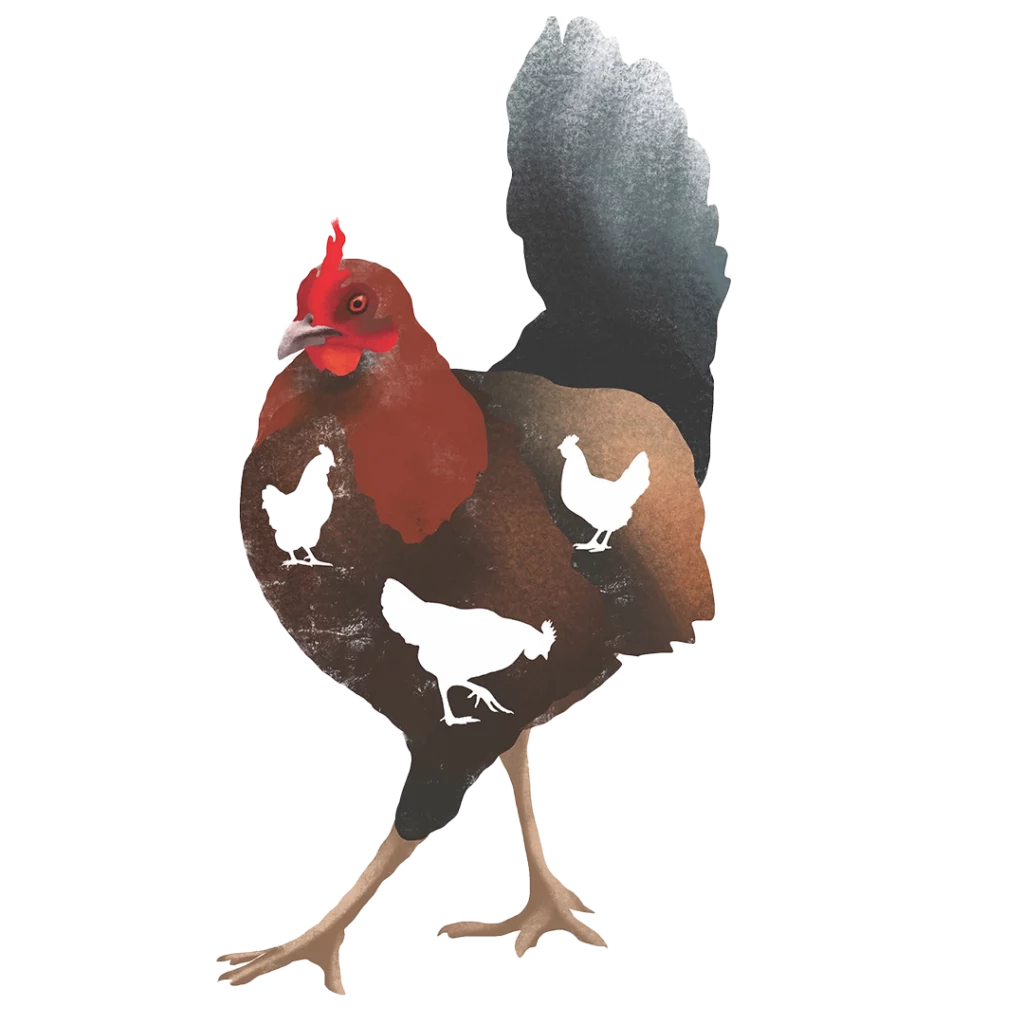
Based on studies he’s done of other feral populations, Florida’s feral chicken populations likely owe their survival to developing an optimized mix of genes suited to their environments—a sweet spot of egg-laying and chick-raising qualities that rivals all their ancestors: “In a wild environment—where you’re surrounded by cars and kids with slingshots and pathogens that the mother can protect the offspring from by oiling their feathers … any genes that contribute to substandard parental care are going to be selected against,” Gering says.
But the birds are also very much their own—influenced by their pasts, but undoubtedly a unique variety: Floridian. “I would wager a tremendous amount on the animals that could be sampled and studied in Ybor and Key West today being quite different from their distant relatives when those populations were first established,” Gering says.
And of course, even after studies are done someday, some specific genetics may never be pinned down—like the crowing-along-to-Jimmy-Buffett-songs gene or the early-morning-roosting-at-Blue-Heaven gene. As all Key West locals know, those just come with the territory.
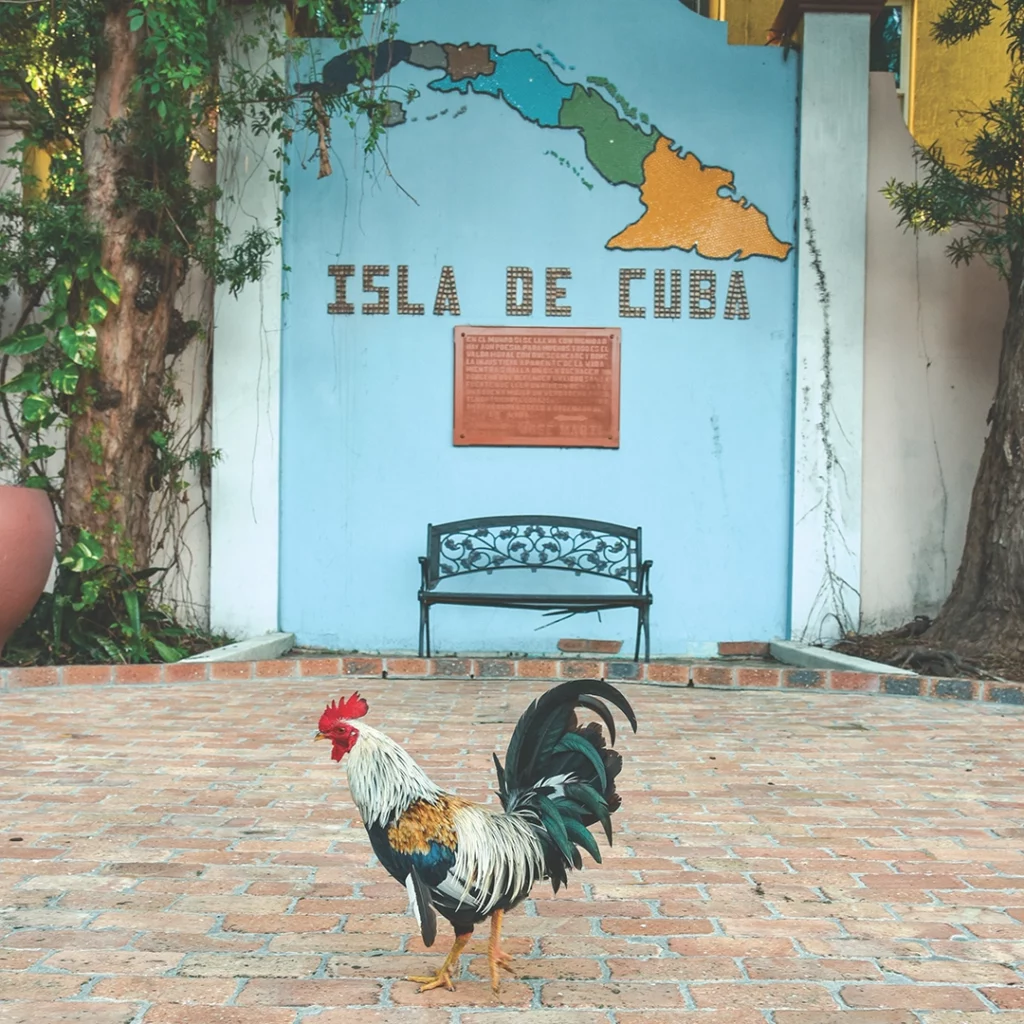
Poultry Paramedics
But not even the most well-adapted chicken (or human) can be fully prepared for the nightlife of these towns. Take Duval Street in Key West, where it’s a never-ending celebration of all that is weird and wonderful about the Sunshine State, with stumbling rum-soaked tourists and a legion of distracted moped drivers. Needless to say, it can be an equally tumultuous environment for a chicken in Ybor City. That’s where the rescuers come in. “I think spring break is my least favorite time of year,” Breese says.
On any given day, Breese might be resuscitating a cold-stunned chick, rehabbing a bird who has been hit by a car or even treating a bullet wound. Since Breese started his rescue, most locals have embraced the idea and are quick to report anything awry.
One of the most common incidents that rescuers respond to is botulism. If that sounds like an illness from the Victorian era, that’s probably because it is. Botulism forms when the perfect storm of bacteria and a lack of oxygen combine to create a toxin. It can happen in improperly canned foods or, in the case of these chickens, when they eat contaminated, decaying things. The toxin could come from the discarded remnants of a late-night Duval Street dive bar. But in most cases, Gary Butcher, a poultry veterinarian at the University of Florida, says the contamination is likely coming from a delicious dead rat: “I don’t think people throwing french fries or Cheetos is going to be a problem for that,” Butcher says. If a bird consumes the toxin from discarded Key lime pie or otherwise, it can end up paralyzed in a state called “limber neck.”

“When it’s paralyzed, it’s not going to get to feed. It’s very prone to predators… So it’s always fatal,” Butcher says. Fatal, that is, unless rescuers like Breese can quickly get to the birds and give them plenty of rest and nourishment. They often do, but in hot summer months, bacteria thrive, and with the sun beating down on the birds, it’s a time-sensitive mission.
Another issue is dumped domestic birds, like Elvis. People who see chickens in Ybor or Key West assume theirs can survive, too, and choose to abandon them. Roosters are the most often abandoned, sticking out like a sore thumb amid the cities’ sleeker birds. As a result, it doesn’t take long for either town’s rescue teams to find them.
“Right now, we have two frizzles or something, I don’t know. Crazy-looking things with Rod Stewart feathers and feathered legs,” says Peggy Coontz, the animal care director at the Key West Wildlife Center. “They’re cute little fluff balls, but they have no business being on the street. Somebody dumped them in a parking lot…It’s just completely irresponsible.”

Fate of the Flocks
It’s the combination of diverse feral genetics and rescuers like Breese and Coontz that protect Florida’s flocks the best. The former is something Breese notices every day: “The (feral birds) are 1,000 times more resilient (than domestic chickens),” he says. “They’re built for it. The genetics are different.” And in an age where avian influenza looms, that genetic diversity is more important than ever.
Florida is home to nearly 100 million chickens used for food production. Across the country, chicken is the leading source of animal protein. While plant-based alternatives are becoming more common, per capita chicken consumption has still doubled in the last 40 years. “There are six chickens alive for every human on Earth,” Gering says. “If a disease … were to happen on a big scale, humanity would be in big trouble very quickly.”
But these feral fowl are cockfighters, backyard birds and jungle fowl all wrapped up into one feathery, Florida-dwelling package—they have an unparalleled amount of genetic diversity. Each feather and tiny talon holds thousands of years of biological history of adaptation. Their DNA has survived traversing oceans, the rise and fall of entire industries and hundreds of thousands of cruise ship passengers stumbling into their habitats annually—all equally monumental feats.
Broiler birds like those in the commercial poultry system don’t have the same genetic diversity. Their limited gene pool puts them at risk, especially as agricultural pandemics become increasingly common. Gering believes studying these few thousand feral birds could lead to clues about increasing resilience among all chickens. Examining the genes of the feral chickens could unearth a hidden adaptation or grant greater insight into the genetic diversity of the overall species.
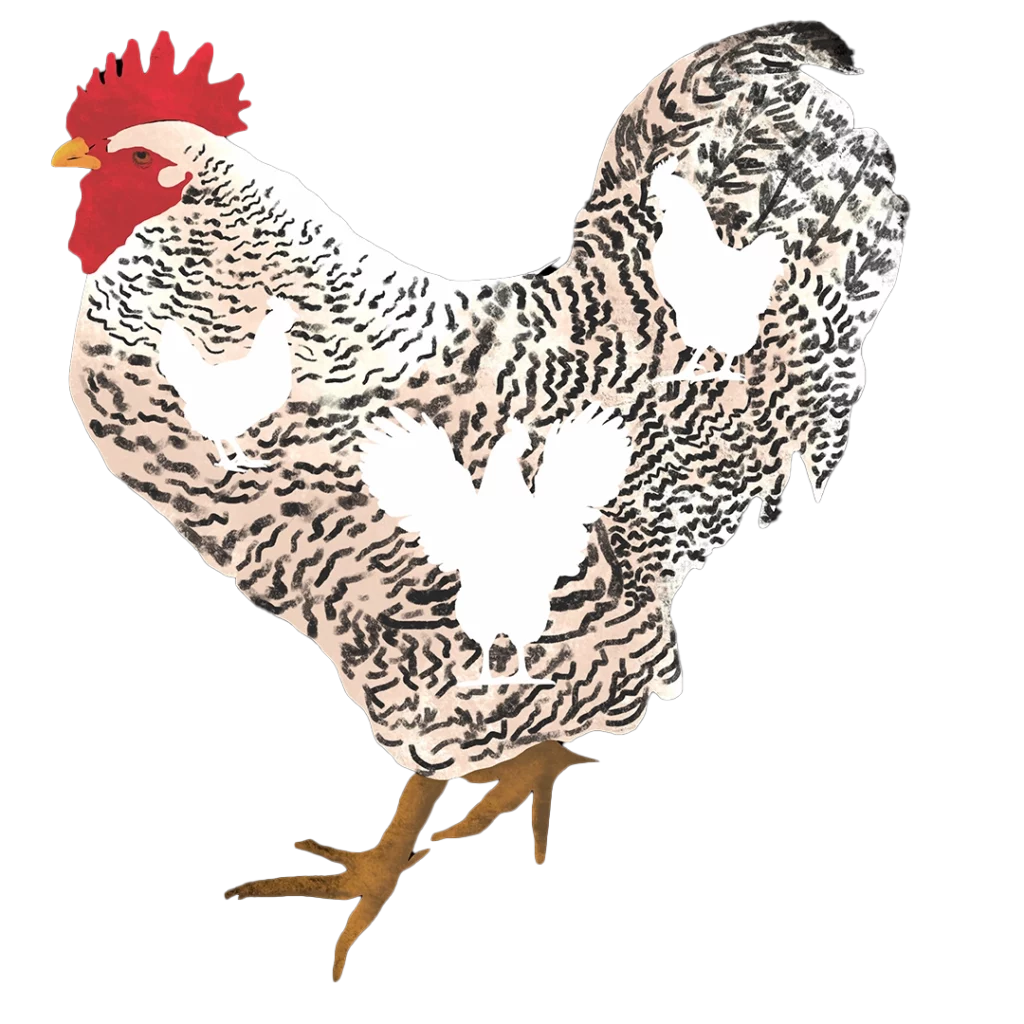
“The environment these animals live in is radically different from the one that they used to in a whole bunch of ways,” Gering says. “We know they can evolve. Who knows? It could be the Ybor population or the Key West population that actually, unknown to us, holds the particular combination of genes that will save the poultry industry someday.”
Regardless of a poultry pandemic, people like Breese will be there. They’ll keep protecting chickens, whether or not we one day need them to protect us, and they’ll preserve the history of Florida along the way.
“Ybor City’s chickens are not just a quirky charm—they embody the neighborhood’s grit,” Breese says. “They are living history. And they are unique little souls who are just trying to exist in an urban environment that their backyard cousins could never imagine. They endure challenges and always persist … They look out for each other and serve as a model for what we should all aspire to be: tough, loyal and free.”





